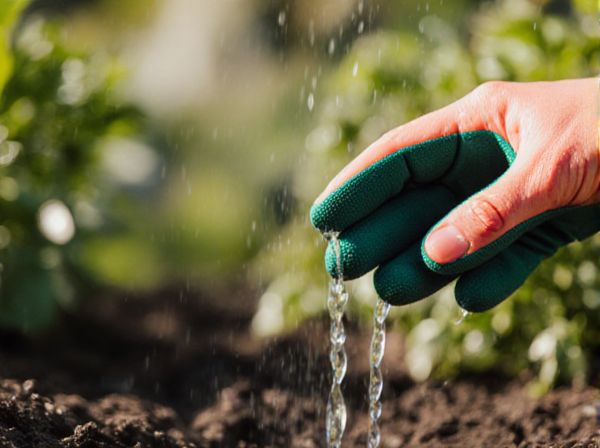
Pre-soaking vs Dry Sowing Illustration
Pre-soaking seeds accelerates germination by softening the seed coat and activating metabolic processes, resulting in faster and more uniform sprouting. In contrast, dry sowing involves planting seeds directly into the soil without prior soaking, which may lead to slower germination but reduces the risk of seed rot in overly wet conditions. Choosing between pre-soaking and dry sowing depends on seed type, soil moisture, and environmental factors to optimize successful plant growth.
Table of Comparison
| Aspect | Pre-soaking | Dry Sowing |
|---|---|---|
| Definition | Seeds soaked in water before planting to initiate germination | Seeds sown directly into soil without prior soaking |
| Germination Speed | Faster germination due to moisture absorption | Slower germination as seeds rely on soil moisture |
| Water Requirement | High initial water use for soaking | Dependent on natural soil moisture |
| Seed Vigour | Higher vigor; reduces dormancy and improves uniformity | May result in variable germination rates |
| Ideal Conditions | Best for hard or dormant seeds | Suitable for seeds adapted to natural soil conditions |
| Risk of Seed Rot | Increased if soaking exceeds recommended time | Lower risk if soil drainage is good |
| Labor Intensity | More labor-intensive due to soaking process | Less labor required; direct sowing |
| Application | Used in agriculture and horticulture to boost germination | Common in large-scale planting and wild seed sowing |
Introduction to Seed Germination Methods
Pre-soaking seeds accelerates germination by hydrating the seed coat, promoting enzyme activation and faster root emergence, making it ideal for hard-coated or dry-stored seeds. Dry sowing involves placing seeds directly into the soil without prior hydration, relying on natural moisture for imbibition and germination, suitable for species with thinner seed coats or where overwatering risks exist. Understanding these methods helps optimize germination success based on seed type and environmental conditions.
Understanding Pre-soaking: What Is It?
Pre-soaking is a germination technique where seeds are submerged in water for a specific period to soften the seed coat and speed up the sprouting process. This method enhances water absorption, reduces germination time, and improves seedling vigor compared to dry sowing, where seeds are planted directly in soil without prior hydration. Understanding pre-soaking helps optimize germination rates, especially for seeds with hard coats or long dormancy periods.
Dry Sowing Explained
Dry sowing involves planting seeds directly into the soil without prior soaking, relying on natural moisture for germination. This method suits hardy seeds with tough coats, reducing the risk of seed rot often seen in pre-soaking. Dry sowing ensures seeds remain in their natural dormant state until optimal conditions trigger sprouting.
Benefits of Pre-soaking Seeds
Pre-soaking seeds accelerates germination by softening the seed coat, allowing water to penetrate more efficiently and activating metabolic processes faster. This method enhances seedling vigor and uniformity, leading to more consistent crop establishment. Pre-soaked seeds often show higher germination rates compared to dry sowing, reducing the risk of uneven growth and seedling loss.
Advantages of Dry Sowing
Dry sowing allows seeds to be planted directly into the soil without pre-soaking, reducing labor and water usage during the germination process. This method enhances seed longevity by preventing premature swelling or rotting that can occur with pre-soaking. Farmers benefit from increased operational efficiency and lower risk of fungal infections associated with excess moisture in pre-soaked seeds.
Factors Affecting Germination Success
Pre-soaking seeds enhances germination rates by softening seed coats and accelerating water uptake, crucial in species with hard seed coats or slow hydration rates. Dry sowing depends heavily on environmental moisture and temperature, making soil conditions and local climate key factors influencing seedling emergence and vigor. Seed viability, oxygen availability, and pathogen presence also significantly impact the success of both pre-soaked and dry sown seeds during germination.
Seed Types Best for Pre-soaking
Seeds with hard coats or larger size, such as beans, peas, and corn, respond best to pre-soaking because it softens the seed coat and accelerates water absorption. Pre-soaking is particularly beneficial for older seeds or those stored in dry conditions, improving germination rates and uniformity. Conversely, small or fine seeds like lettuce and carrots typically do not require pre-soaking and perform well with dry sowing.
Seeds That Prefer Dry Sowing
Seeds that prefer dry sowing, such as lupines, cornflowers, and certain wildflowers, benefit from direct soil contact without pre-soaking to avoid fungal infections and rotting. Dry sowing allows the seed coat to naturally soften through environmental moisture fluctuations, promoting stronger root development and better germination rates in species adapted to this method. These seeds often require stratification or exposure to cold periods after dry sowing, which mimics natural seasonal cycles crucial for breaking dormancy and triggering germination.
Common Mistakes and Troubleshooting
Pre-soaking seeds often leads to over-saturation, causing poor oxygen absorption and increased risk of fungal infections, while dry sowing may result in uneven germination due to inconsistent moisture levels. Common mistakes include soaking seeds too long or planting dry seeds too deeply, which delays sprouting or causes seed rot. To troubleshoot, maintain optimal soaking times specific to seed type and ensure dry sown seeds receive consistent moisture without waterlogging.
Choosing the Right Method for Your Garden
Pre-soaking seeds accelerates germination by softening the seed coat, making it ideal for hard-coated or slow-germinating varieties such as beans and peas. Dry sowing suits seeds with natural dormancy that require soil stratification, like carrots and lettuce, promoting stronger root development and easier transplanting. Selecting the appropriate method depends on seed type, soil conditions, and desired germination speed to ensure optimal plant growth in your garden.
Pre-soaking vs Dry Sowing Infographic

 gardendif.com
gardendif.com